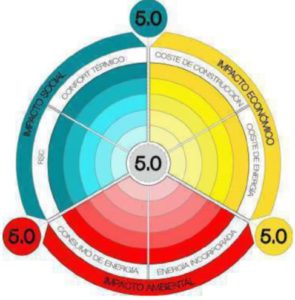Ms. Michelle Imperia Sánchez de León Brajkovich’s Thesis Lecture

SUSTAINABLE LIFE CYCLE ASSESSMENT OF THE VERTICAL OPAQUE ENVELOPE. Methodology Assessment of Environmental, Economic and Social Impact
Author: Sánchez de León Brajkovich, Michelle Imperia
Directora: PhD. Martí Audí, Núria
Codirector: PhD. Wadel Raina, Gerardo
Date: 14th of September of 2017
Place: Hall of Degrees
Tribunal: Ph.D. Jaume Avellaneda Díaz Grande, Ph.D. Belinda López Mesa and Ph.D. Paulo Mendoça
Abstract: This thesis is part of a reflection about the definition of Sustainable Development and the Triple Bottom Line; and how to apply this concept to the construction field. Understanding by the Triple Bottom Line, the balance of three types of impact, environmental, economic and social.
Presently, the architects focus on developing strategies to reduce the buildings environmental impact; following regulations and market indicators that focus, almost entirely on reducing the energy consumption during the Use stage of a building. In this way, we call sustainable to the buildings that are energy efficient, and we lose our sight on the economic and social impact by itself and on the entire life cycle of a building.
This research is base in these concerns when looking for a new methodology that includes the Life Cycle Analysis – LCA-, with the evaluation of the environmental, economic and social impact of an architectural element or building. This evaluating system shall be verifiable, transferable and easy to apply.
To study and develop this methodology, it takes as a case study, the exterior wall, since it is consider as the most important architectonic element at an environmental impact level.
Therefore, this research begins with the analysis of the facade constructive systems, classifying them in terms of sustainable contributions at a level of physical processes that a building overtakes in response to local climate. Then, there were selected five types of exterior walls to apply the developed methodology, reaching the conclusions on its sustainable performance, evaluating its environmental, economic and social impact.
Finally, it develops another research level, comparing different compositions, in terms of construction materials for the five selected typologies. When ending, it generates a list of design guidelines so that future architects can use this thesis to improve the design of building envelopes.
In turn, the evaluation methodology is use as a tool to develop comprehensive analysis of the building sustainability level or architectural elements that may lead to improvement in the design.
This way, tools are offered to improve the sustainability level of buildings, opening the look of that really sustainable, focused on the balance of the three types of impacts of the Sustainable Development Triple Bottom Line. Key Word: Life Cycle Assessment, sustainability, facade, envelope, exterior wall construction, technical requirements, new construction, constructive system, energy efficiency, Triple Bottom Line, Environmental Impact, Economic Impact, Social Impact.
